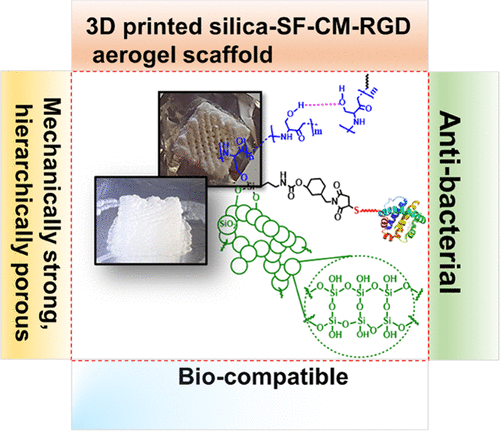当前位置:
X-MOL 学术
›
ACS Biomater. Sci. Eng.
›
论文详情
Our official English website, www.x-mol.net, welcomes your
feedback! (Note: you will need to create a separate account there.)
3D Printing of Antibacterial, Biocompatible, and Biomimetic Hybrid Aerogel-Based Scaffolds with Hierarchical Porosities via Integrating Antibacterial Peptide-Modified Silk Fibroin with Silica Nanostructure
ACS Biomaterials Science & Engineering ( IF 5.4 ) Pub Date : 2021-08-20 , DOI: 10.1021/acsbiomaterials.1c00483 Nighat Karamat-Ullah 1 , Yan Demidov 1 , Michael Schramm 2 , Daniela Grumme 2 , Jaqueline Auer 3 , Christoph Bohr 1 , Bent Brachvogel 4 , Hajar Maleki 1
ACS Biomaterials Science & Engineering ( IF 5.4 ) Pub Date : 2021-08-20 , DOI: 10.1021/acsbiomaterials.1c00483 Nighat Karamat-Ullah 1 , Yan Demidov 1 , Michael Schramm 2 , Daniela Grumme 2 , Jaqueline Auer 3 , Christoph Bohr 1 , Bent Brachvogel 4 , Hajar Maleki 1
Affiliation

|
Scaffold-mediated tissue engineering has become a golden solution for the regeneration of damaged bone tissues that lack self-regeneration capability. A successful scaffold in bone tissue engineering comprises a multitude of suitable biological, microarchitectural, and mechanical properties acting as different signaling cues for the cells to mediate the new tissue formation. Therefore, careful design of bioactive scaffold macro- and microstructures in multiple length scales and biophysical properties fulfilling the tissue repair demands are necessary yet challenging to achieve. Herein, we have developed an antibacterial and biocompatible silica-silk fibroin (SF) gel-based ink through novel yet simple chemical approaches of sol–gel and self-assembly followed by processing the obtained gels as three-dimensional (3D) hybrid aerogel-based scaffolds exploiting the advanced materials design approaches of micro-extrusion-based 3D printing, and directional freeze-casting/drying approaches. As the main constituent of the hybrid biocompatible scaffold of this study, we used the SF extracted from Bombyx mori silkworm cocoon. However, to increase the cell responsivity and bactericidal efficiency of the final scaffold, thiol-ended antimicrobial and cell adhesive peptide sequence (SH-CM-RGD) was conjugated to silica-SF hybrid gels via covalent attachment using a spacer molecule through either preprint (prior to sol–gel) or during the post-printing steps on the previously printed silica-SF gel. In the next step, the hybrid Silica-SF-CM-RGD hydrogel ink was 3D-printed into the construct with interconnected porous structure with hierarchically organized porosity and a combination of several promising properties. Namely, due to the covalent linkage of the antibacterial peptide to the SF, the scaffold shows potent bactericidal efficiency toward Gram-positive and Gram-negative bacteria. Moreover, nanostructured silica components in the 3D-printed composites could intertwine with SF-CM-RGD to support the mechanical properties in the final scaffold and the final osteoconductivity of the scaffold. This study supports the promising properties of 3D-printed silica-SF-based hybrid aerogels constructs for repairing bone defect.
中文翻译:

通过将抗菌肽修饰的丝素蛋白与二氧化硅纳米结构相结合,3D 打印具有分级孔隙的抗菌、生物相容性和仿生混合气凝胶支架
支架介导的组织工程已成为缺乏自我再生能力的受损骨组织再生的黄金解决方案。骨组织工程中成功的支架包括多种合适的生物、微结构和机械特性,作为细胞介导新组织形成的不同信号提示。因此,仔细设计多个长度尺度的生物活性支架宏观和微观结构以及满足组织修复需求的生物物理特性是必要的,但实现起来具有挑战性。在此处,我们通过溶胶-凝胶和自组装的新颖而简单的化学方法开发了一种抗菌和生物相容性二氧化硅-丝素蛋白 (SF) 凝胶基墨水,然后将获得的凝胶加工为三维 (3D) 混合气凝胶基支架利用基于微挤压的 3D 打印的先进材料设计方法和定向冷冻铸造/干燥方法。作为本研究混合生物相容性支架的主要成分,我们使用了从家蚕蚕茧。然而,为了提高最终支架的细胞反应性和杀菌效率,硫醇末端抗菌和细胞粘附肽序列(SH-CM-RGD)通过使用间隔分子通过任一预印物的共价连接与二氧化硅-SF混合凝胶结合(在溶胶-凝胶之前)或在先前印刷的硅胶-SF 凝胶上的印刷后步骤期间。在下一步中,将混合二氧化硅-SF-CM-RGD 水凝胶墨水 3D 打印到具有互连多孔结构的结构中,该结构具有分层组织的孔隙率和多种有前途的特性的组合。即,由于抗菌肽与 SF 的共价连接,支架显示出对革兰氏阳性和革兰氏阴性细菌的有效杀菌效率。而且,3D 打印复合材料中的纳米结构二氧化硅组分可以与 SF-CM-RGD 交织在一起,以支持最终支架的机械性能和支架的最终骨传导性。这项研究支持了 3D 打印的基于二氧化硅-SF 的混合气凝胶结构用于修复骨缺损的有希望的特性。
更新日期:2021-09-13
中文翻译:

通过将抗菌肽修饰的丝素蛋白与二氧化硅纳米结构相结合,3D 打印具有分级孔隙的抗菌、生物相容性和仿生混合气凝胶支架
支架介导的组织工程已成为缺乏自我再生能力的受损骨组织再生的黄金解决方案。骨组织工程中成功的支架包括多种合适的生物、微结构和机械特性,作为细胞介导新组织形成的不同信号提示。因此,仔细设计多个长度尺度的生物活性支架宏观和微观结构以及满足组织修复需求的生物物理特性是必要的,但实现起来具有挑战性。在此处,我们通过溶胶-凝胶和自组装的新颖而简单的化学方法开发了一种抗菌和生物相容性二氧化硅-丝素蛋白 (SF) 凝胶基墨水,然后将获得的凝胶加工为三维 (3D) 混合气凝胶基支架利用基于微挤压的 3D 打印的先进材料设计方法和定向冷冻铸造/干燥方法。作为本研究混合生物相容性支架的主要成分,我们使用了从家蚕蚕茧。然而,为了提高最终支架的细胞反应性和杀菌效率,硫醇末端抗菌和细胞粘附肽序列(SH-CM-RGD)通过使用间隔分子通过任一预印物的共价连接与二氧化硅-SF混合凝胶结合(在溶胶-凝胶之前)或在先前印刷的硅胶-SF 凝胶上的印刷后步骤期间。在下一步中,将混合二氧化硅-SF-CM-RGD 水凝胶墨水 3D 打印到具有互连多孔结构的结构中,该结构具有分层组织的孔隙率和多种有前途的特性的组合。即,由于抗菌肽与 SF 的共价连接,支架显示出对革兰氏阳性和革兰氏阴性细菌的有效杀菌效率。而且,3D 打印复合材料中的纳米结构二氧化硅组分可以与 SF-CM-RGD 交织在一起,以支持最终支架的机械性能和支架的最终骨传导性。这项研究支持了 3D 打印的基于二氧化硅-SF 的混合气凝胶结构用于修复骨缺损的有希望的特性。











































 京公网安备 11010802027423号
京公网安备 11010802027423号